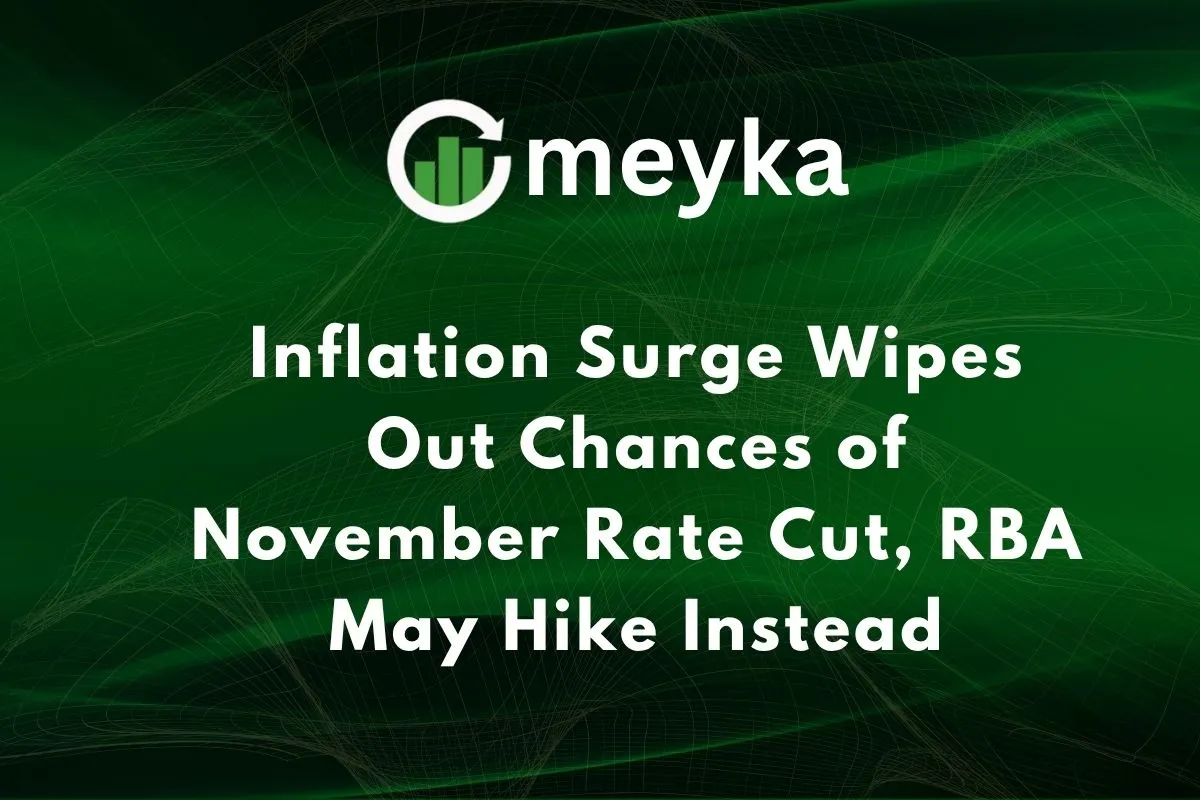Inflation Surge Wipes Out Chances of November Rate Cut, RBA May Hike Instead
Inflation in Australia has surged to 3.2% for the year to September 2025, far above the Reserve Bank of Australia’s (RBA) target band of 2%–3%. This sharp uptick is concentrated in sectors such as electricity (+24% year-on-year) and groceries (+3.1%). For investors following monetary policy-sensitive markets, this jump in inflation is the key reason the RBA’s chance of a November rate cut has collapsed; market pricing now puts it at only about 8%. Looking ahead, the central bank may even consider a rate hike if inflation proves persistent. The takeaway: inflation is back on the radar, and that shifts the interest-rate outlook, which has direct implications for equities, fixed income, and real estate.
The Inflation Trend and Why It Matters
What the data shows
Inflation accelerated sharply in Q3 2025: headline CPI rose 1.3% for the quarter, its fastest pace in 2½ years. The trimmed-mean measure of core inflation (which excludes volatile items) rose 1.0% in the quarter and reached 3.0% annually. That core reading is materially above the RBA’s own forecasts. Underlying inflation had been easing earlier in the year, so this rebound catches policymakers off guard. As noted by the RBA Governor, Michele Bullock, the bank now sees more risk from inflation than from a rising unemployment rate of around 4.5%.
Why inflation changes policy odds
This inflation uptick throws cold water on expectations of near-term rate cuts. With inflation back above the upper bound of the target band, the RBA must prioritise price stability. If the bank cuts rates while inflation remains elevated, it risks undermining its credibility and reigniting inflation expectations. Market reaction confirms this: the probability of a November cut fell from around 40% to 8%.
Investor Takeaway: For investors, rising inflation means higher interest-rate risks, which tend to weigh on growth stocks, high-multiple equities, and duration-sensitive assets. On the flip side, financials, commodities and energy stocks often fare better in higher-inflation regimes. We should prepare for a scenario of “higher for longer” rates rather than “rate cuts incoming”.
The RBA’s Changing Rate Path
Recent decisions and signals
The RBA cut its cash rate three times earlier this year, taking it to 3.60% by August. But minutes and commentary from October reveal a hawkish tilt: the bank noted that further easing was not being discussed and that the neutral rate might be around 3.25%.
What the surge in inflation implies
With inflation running ahead of forecasts, the RBA is unlikely to cut rates next month. More critically, the bank might even consider a rate increase if inflation persists. Some economists now say the next cut won’t come until H1 2026.
Investor Takeaway: For investors, this shift means monetary policy will remain tighter for longer. Borrowing costs will stay elevated, putting pressure on interest-rate sensitive sectors (like property and consumer discretionary). That suggests tilting portfolios toward sectors that benefit from higher rates or inflation (for example, financials, infrastructure, energy).
Broader Economic and Market Implications
Impact on households and the economy
Higher inflation erodes real incomes and can dampen consumer spending. The electricity component alone rose 24% year-on-year, which directly hits household budgets. With the labour market still relatively tight (unemployment ~4.5%), the RBA is confronted with the classic “no clean trade-off” between growth and inflation.
Impact on markets and sectors
Equities: Growth stocks priced on low-for-long interest rates may suffer. Financials: Banks may benefit from higher net interest margins in a rising-rate environment. Real estate: Elevated rates typically dampen housing demand and valuations. Commodities: Inflation-linked commodity prices may gain.
Investor Takeaway: We should position for a regime of elevated inflation and interest rates. That means favouring sectors with pricing power, inflation hedging capabilities, or minimal interest-rate sensitivity. At the same time, risk management becomes more important, and tighter monetary conditions raise the bar for earnings growth.
Conclusion
Inflation has re-emerged as the dominant risk in Australia’s economic outlook. At 3.2% annual headline inflation and 3.0% core inflation, the RBA is unlikely to deliver a rate cut in November, and may resort to a hike if inflation persists.
For investors, this means adjusting to a new paradigm: tighter monetary policy, elevated interest rates, and heightened inflation risk. We recommend favouring sectors with pricing power or inflation linkage, maintaining defensive positioning in rate-sensitive assets, and monitoring inflation trends closely. As the RBA holds firm, those relying on a “rate relief” narrative need to recalibrate expectations. Staying adaptive and data-driven will be key in navigating this environment.
FAQS
Headline inflation rose by 1.3% in the quarter, driven by a 24% surge in electricity prices and higher travel and services costs. Underlying inflation also accelerated, pulling the trimmed mean reading to 3.0% annually. That reversal from earlier easing prompted concerns the inflation fight isn’t over.
Yes, while not guaranteed, the probability of a further rate cut in 2025 is near zero (about 8% for November), and the RBA is even signalling rate hikes remain on the table if inflation stays high.
Investors should favour sectors resilient to inflation (like commodities, infrastructure, and financials) and reduce exposure to long-duration, growth-oriented stocks that rely on low interest rates. Diversification and inflation hedging become more important.
Yes. Higher inflation and higher interest rates typically dampen housing affordability and borrowing capacity. With the cash rate unlikely to fall soon, mortgage costs are likely to stay elevated, reducing demand and potentially putting downward pressure on valuations.
Disclaimer:
The content shared by Meyka AI PTY LTD is solely for research and informational purposes. Meyka is not a financial advisory service, and the information provided should not be considered investment or trading advice.






